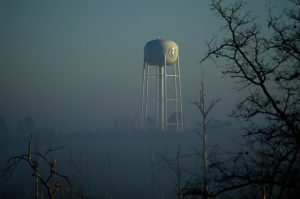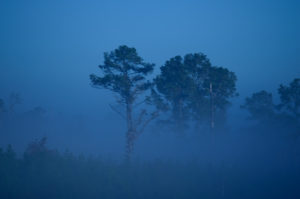I could subsist on morning mist—Jarod Kintz
We have all been enchanted, at one time or another, by some awesome display of nature. A field of wildflowers, a pastel rainbow, big mountains in mantles of snow, sunlight reflected on the water, the rich white inner light of a full moon. Why do we notice? By what force is our attention stolen, seemingly beyond our power to resist? Could it be the rarity—the fear that we may never again witness a sight so grand? Is it because we don’t understand? Everyone loves a mystery. Regardless, there is a permanent image created—a memory—that we can call on to recreate the moment, whenever we have the impulse. It’s foolish to attempt to rank these experiences, to create a top-ten list of most favorite happenings but, for me, the morning mist is among my most favorite.
As dawn begins to break, a pearly light, haunted and beautiful, catches my eye. Instinctively I know its all timing, one of those special moments . . . some profound change  has occurred; something left, something new has arrived, a secret unfolds. There it is, just hanging out—the morning mist. What is it protecting? Why is it there? What does it mean? It’s opaque, yet not really. When you stop and look—really look—the world still exists within its sheath but the contours are blurred and underlying forms melt into one another. And the colors. They change from dark and brooding, barely discernable from the night, then turn monochrome blue, and as the sun gently silhouettes the morning, unique and rare colors infuse—colors found nowhere else in life. Secret blues and silvery lavenders, like the light in fairy tales. Whether this is God’s artistry or merely an illusion matters not—it’s riveting.
has occurred; something left, something new has arrived, a secret unfolds. There it is, just hanging out—the morning mist. What is it protecting? Why is it there? What does it mean? It’s opaque, yet not really. When you stop and look—really look—the world still exists within its sheath but the contours are blurred and underlying forms melt into one another. And the colors. They change from dark and brooding, barely discernable from the night, then turn monochrome blue, and as the sun gently silhouettes the morning, unique and rare colors infuse—colors found nowhere else in life. Secret blues and silvery lavenders, like the light in fairy tales. Whether this is God’s artistry or merely an illusion matters not—it’s riveting.
From a purely scientific viewpoint, we know it’s nothing but water vapor suspended in the air, brought about by changes in temperature. Visible condensation destined to evaporate once surface temperatures climb. Meteorologists talk of ambient warmth, humidity levels and dew points, all factors in a formula, capable of being calculated out to three decimal places. No mystery here. But I am not moved by formulas or the practical algebra of science. Marshes and ponds, familiar crucibles for mist, are teeming with life. Critters large and small claim these areas as preferred habitat, but even this knowledge does not capture—as miraculous as it is—my imagination. Science leaves little to fire my imagination, for in that discipline understanding is more important than appreciation. But in art’s realm, appreciation comes first. Stumbling upon a patch of low-lying morning mist is, to me, a special opportunity—requiring that I stop and appreciate.
Not everyone is enamored of mist as I, or if they are, it’s for different reasons. Some consider mist and swamps a package. One begets the other. Shadows and cloudy contour belong to things from another world, a sorcerer’s domain. Mist, hanging distant and ethereal like a mirage over some wooded forest bog, is where monsters lurk, the lair of hideous creatures, twisted psychopaths or the backdrop for violent murders. It is a rich middle earth, the source of science fiction fantasies, a den of secrets. It’s where you go to ditch evidence, or the creepy setting of some Stephen King novel. While I can understand this association with the eerie, I am seldom affected that way. The early morning mist does make me reflect, but not about mayhem and death. I am possessed by its enigma.
the lair of hideous creatures, twisted psychopaths or the backdrop for violent murders. It is a rich middle earth, the source of science fiction fantasies, a den of secrets. It’s where you go to ditch evidence, or the creepy setting of some Stephen King novel. While I can understand this association with the eerie, I am seldom affected that way. The early morning mist does make me reflect, but not about mayhem and death. I am possessed by its enigma.
I especially like the high mountain ranges in the morning: after the sun scatters the low clouds, uncovering miles of glistening vapor, blanketing the crags in broad bands of thin glassy-transparent mist. It’s like watching the earth come awake from a private skybox, a gradual arousal of life revealed as the heavy cover of the night is rolled back. Solitary bird calls punctuate the chill morning air, clear but distant, fresh and ready for the day. Soon, others join in and previously hidden movements can be spotted through a long lens—the animals are busy looking for breakfast, lean and practiced from the life struggle. Life happens anew.
All sunrises are worth savoring, yet not all of them are accompanied by morning mist. When they are, the experience is richer, more striking. The mist adds an element of respect to that which has gone before, for it is timeless. As I gaze onto this translucent mask of vapors, could it be this is how our planet looked at its birth? Gasses and solids suspended, emulsified together, scarcely indistinguishable from where I stand? It’s easy to imagine glimpsing a triceratops, thirty feet long, lumbering from the steamy edge, like some elephantine lizard grazing his way up to higher ground. Or a Spanish conquistador as he breaks from the ivory mist, a sharp glint of sunlight reflected from the bridle as his charger tosses its head, its breath a silver plume. We know from history these events have occurred, perhaps glimpsed from this very hillside. How curious. Could prehistoric ancestors have actually stood where I now stand? Could this be the exact same mist, present at the time, having re-emerged through countless conversions from liquid to gas and back again? Am I staring at eternity itself?

Then there is the matter of vantage point. From the inside looking out, fog is foreboding and ominous. . .a thick blanket of atmosphere sucking you into its soul, swallowing you up. There are few natural phenomenon more frightening than navigating through this stuff. I have a war memory as a helpless passenger in a Huey helicopter, gingerly nosing our way up the side of a socked-in mountain, attempting to keep visual contact with the treetops without striking them. No longer in control, totally in the hands of fate—it is the fog that decides events. Visceral, primordial. . .not so pretty when you’re this close. Beauty is often at its best when unapproachable.Vantage point matters. Steam trains, treacherous mountains and morning mist are best appreciated from a distance.
The mist is a life force. It comes into being from nothingness, transforms quickly, flourishes for a short while and then disappears back into the void. Day and night  cannot, after all, coexist. The serious observer is left wondering; spectral and fleecy, the mist speaks to unknowns—the primeval source of things, perhaps unknowable. It is at once a beginning–the start of something new—yet slips away before our eyes. This much is knowable: beauty and loss travel together . . . all is temporary. The histories of our lives are mere pages from this same book.
cannot, after all, coexist. The serious observer is left wondering; spectral and fleecy, the mist speaks to unknowns—the primeval source of things, perhaps unknowable. It is at once a beginning–the start of something new—yet slips away before our eyes. This much is knowable: beauty and loss travel together . . . all is temporary. The histories of our lives are mere pages from this same book.


